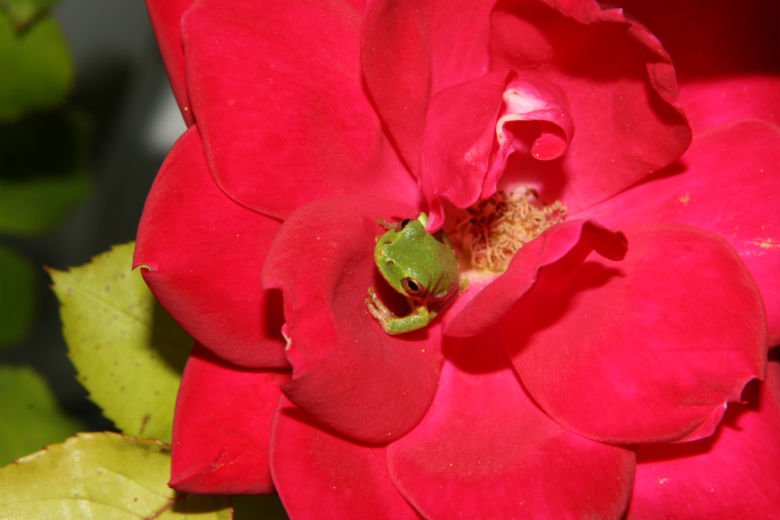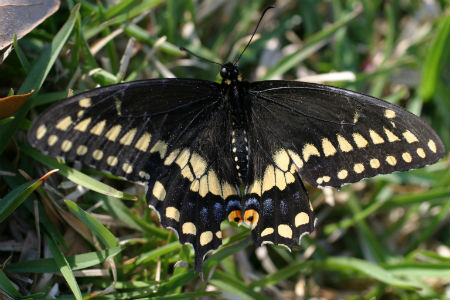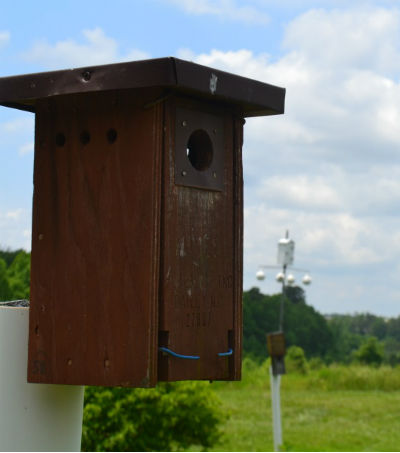RALEIGH — Raising their voices to talk over the noisy chatter coming from a nearby purple martin birdhouse, people at the Gardening for Wildlife workshop share childhood memories of early experiences enjoying gardens. Resembling an oversized birdhouse, the outdoor classroom at the Prairie Ridge Ecostation makes for an appropriate setting to learn gardening techniques that attract native wildlife.
Thirteen participants gathered at the field station on a weekday in late May for the free workshop sponsored by the N.C. Museum of Natural Science. The view from the screened walls of the classroom gives a glimpse of what the Piedmont used to be, and – hope workshop leaders Kimberly Smart and Brian Hahn – what we can begin to restore, starting in our own backyards.
Supporter Spotlight
 Kimberly Smart, education coordinator, gives a training on gardening for wildlife at the Prairie Ridge Ecosystem. Photo: Caroline Pitt Loomis |
Smart, education coordinator at Prairie Ridge, tosses vines and branches of green plants onto the floor. She names some of the common culprits: kudzu, Japanese honeysuckle, reed grass, and autumn olive. Some of these invade our backyards without an invitation, others we work weekends to make them feel at home. All are familiar faces in North Carolina. And all are non-native species.
The familiar story of the creeping kudzu choking our green spaces or monocultures of reed grass in our wetlands offers frightening examples of what our preference for exotic plants can do to the native ecosystem. But the strongest influence of non-native plants within our backyards may be on some of the smallest, and perhaps most vital, visitors in our gardens: insects.
“Insects are a link in the chain to plants and the animals that eat those plants,” explains Smart.
In addition to pollination and seed dispersal, insects play a vital role in transferring energy from plants to the animals that are unable to digest plants directly. While some non-native plants might provide shelter and food for four or five species of insects, many native plant species can host up to fifty species of insects at varying stages of their development. With 96 percent of the terrestrial bird species in North Carolina relying on insects to feed to their young, the reduced capacity for an ecosystem dominated by non-native plants to support a diversity of insects can spell trouble for the birds and mammals that rely on them.
“If it says pest-free, that means it is at least exotic. [It is pest-free] because insects here won’t feed on it,” Brian Hahn, a natural resource technician at Prairie Ridge, explains to the group about some of the dangers of planting many of the exotic plant species commonly found at local garden stores and nurseries.
Supporter Spotlight
But even this crowd of conscientious gardeners wants to protect their yards from the destruction caused by ravenous caterpillars. Questions come up about what can be done about other unwanted visitors, such as mosquitoes and slugs.
 Tree frogs, such as this one, can eat dozens of bugs a day. Photo: Sam Bland |
Hahn explains how building a garden full of native plant species invites balance into your yard, and requires less care and maintenance to thrive than a garden full of non-native species that evolved to live in a different ecosystem and climate. A garden full of native plant species supports not only the insects, but also the predators that keep these insect populations under control. A single bluebird pair, for example, can eat up to three hundred caterpillars in a day. That makes for pretty effective pest control.
“If you plant it, they will come,” says Smart, explaining how adding a simple water box for native pond plants, such as white water lily or bladderwort, will also attract dragonfly nymphs that prey on mosquitos.
“That is the whole answer – more native plants,” Smart stresses.
Non-native plants often require the use of toxic pesticides and fertilizers to keep them happy and insect free, causing harmful nutrient and chemical runoff that threatens the health of our waterways and coast. And because native plants have evolved to live with the weather that we have, they are much more drought tolerant than non-native species.
Smart and Hahn lead the group to a demonstration garden stocked full of sun-loving North Carolina native plants in everything from raised beds to bogs and rain gardens. Large vines of coral honeysuckle hang from the deer-proof fencing. Butterflies, bees, dragonfly nymphs and birds can be spotted all within the same corner of the garden.
 This black swallowtail butterfly takes advantage of a native planting. Photo: Sam Bland |
Smart describes the garden as “evangelical” to demonstrate to people that they can have a native garden that still looks orderly.
The garden is decorated with artificial structures that attract wildlife. “Bee blocks” built out of discarded lumber or logs attract non-aggressive orchard bees, which, unlike the honeybee, are native to the United States. Frog pipes built out of PVC pipes and “toad abodes” made from halved pots, provide shelter for frogs, toads and other pest-controlling creatures. Hahn emphasizes the importance of adding a water structure, saying it is good for all insect and animal visitors, but stresses that an escape route should always be provided to prevent accidental drowning of smaller creatures.
As the workshop comes to an end the participants discuss a program developed by the National Wildlife Federation to certify private yards as national wildlife habitat. Raleigh already has approximately seven hundred certified backyard habitats.
“If we all made our property havens for the plants, and the bugs and birds that eat them, it would be like this vast, disjunct national park,” Smart says with a smile.
 Birdhouses bring bug-eating masters to the back yard. Photo: Caroline Pitt Loomis |
Each of the participants leaves the workshop toting small pots of native plants from the demo garden. They’re off to bring a little bit of nature back to North Carolina in their own backyards.
For more information about which plant species that are native to the coastal region or any other places in the state refer to the North Carolina Native Plant Society’s web site.
The North Carolina Coastal Federation sells hundreds of locally adapted native plants at its headquarters office in Ocean, between Morehead City and Swansboro. For information on what we have in stock, email Rose Rundell at roser@nccoast.org







